
German postcard by Ross-Verlag, no. 3980/3, 1928-1929. Photo: Paramount.
American actress Clara Bow (1905-1965) rose to stardom in silent film during the 1920s. It was her appearance as a plucky shopgirl in the film It (Clarence G. Badger, 1927) that brought her global fame and the nickname 'The It Girl'. Bow came to personify the Roaring Twenties and is described as its leading sex symbol.

German postcard by Ross Verlag, no. 3510/1, 1928-1929. Photo: Paramount.
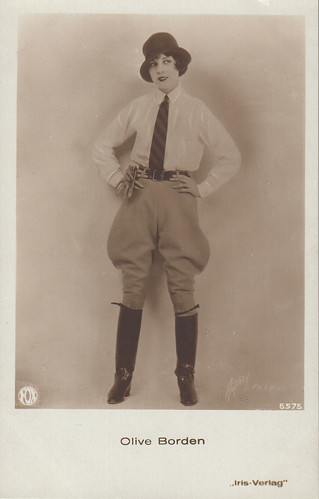
Austrian postcard by Iris Verlag, no. 6575. Photo: Max Munn Autrey / Fox. Collection: Marlene Pilaete.
Stunning Olive Borden (1906-1947) was considered one of the most beautiful actresses of the silent era. At 15, she started as a Mack Sennett bathing beauty and reached the peak of her career in 1926 when she made 11 films for Fox Studios and was earning $1,500 a week. She was nicknamed "the Joy Girl", after playing the lead in the 1927 film of that same title, but soon her career waned.

German postcard by Ross Verlag, no. 4681/1, 1929-1930. Photo: Paramount. Charles Rogers and Nancy Carroll in Close Harmony (John Cromwell, A. Edward Sutherland, 1929).
Red-haired, cupid-bow-mouthed Nancy Carroll (1903-1965) became a very popular Hollywood star upon the advent of sound film because of her singing and dancing abilities. She was reported to have received more fan mail than any of her Hollywood peers of the same era. As she expanded her acting range from flaming flapper to ditzy comedienne to sensitive heroine, she was nominated for an Oscar for The Devil's Holiday (1930).

French postcard by Cinémagazine-Edition, no. 765. Photo: Otto Dyar.

German postcard by Ross Verlag, no. 3839/2, 1928-1929. Photo: Max Munn Autrey / Fox Film.
Madge Bellamy (1899-1990) was a beautiful and temperamental leading lady of the silent era, known for such classics as John Ford's first Western The Iron Horse (1924). Because of her off-set temperament, she was nicknamed "Miss Firecracker". She appeared in about fifty silent films and also in a dozen sound films, including the cult favourite White Zombie (1932). By the late 1930s, her film career had virtually ended, but in 1943 she became again fodder for the press when she was arrested for shooting her former lover.

French postcard by Europe, no. 655. Photo: First National / Arta Film.
American actress Colleen Moore (1899-1988) was a star of the silent screen who appeared in about 100 films beginning in 1917. During the 1920s, she put her stamp on American social history, creating in dozens of films the image of the wide-eyed, insouciant flapper with her bobbed hair and short skirts.

German postcard by Ross Verlag, no. 4943/1, 1929-1930. Photo: First National Pictures / Defina. Colleen Moore and Antonio Moreno in Synthetic Sin (William A. Seiter, 1929).
That's the bee's knees
The Flapper style originated in the 1920s in the United States during the period of Prohibition, in illegal bars (speakeasies), where religiously inspired abstinence and authority, in general, were scorned. The flapper lifestyle became especially popular in England and the United States.
The flapper was the model for an entirely new style of fashion that included the end of the corset and the rise of the pantyhose. Sarah Pruitt at History.com: "Flappers wore their skirts shorter so they could show off their legs and ankles—but also so they could dance. They particularly loved the Charleston, a 1920s dance craze involving waving arms and fast-moving feet that had been pioneered by African Americans, first in the South and later in Harlem. Dancing proved challenging in traditional women’s fashion, not only with long dresses, but also traditional corsets that tightly bound a woman’s midsection and accentuated her waist."
Around 1923, French designer Coco Chanel introduced what became known as the “garçonne look”, featuring not just high hemlines but dropped or nonexistent waistlines and straight, sleeveless tops. With lighter and more flexible undergarments that created a straight, slim silhouette, this new design allowed women to dance freely. Flappers wore heavy make-up, short skirts, drank heavily, smoked, and drove cars.
The first appearance of the flapper style in the United States came from the popular Frances Marion film, The Flapper (Alan Crosland, 1920), starring Olive Thomas. The flapper-girls also had their own slang, with words and phrases all their own, such as 'snugglepup' (a man who often goes to parties), 'barney-mugging' (sexy), or 'That's the bee's knees' (that's great) and 'That's so Jake'.
Famous flappers included actresses Joan Crawford, Clara Bow, Louise Brooks, Colleen Moore, Norma Talmadge, Carla Laemmle, and authoress Zelda Fitzgerald, whose husband F. Scott Fitzgerald paid much attention to the flapper style in his work. Cartoon characters such as Minnie Mouse and Betty Boop were also inspired by the flapper style.
In Europe, the French dancer Mistinguett was a well-known flapper, who introduced the bob hairstyle at the Moulin Rouge (cabaret) in 1921. In Berlin around 1930, the Swiss writer and photographer Annemarie Schwarzenbach and the German writer and actress Ruth Landshoff-Yorck were at the centre of a circle of free-spirited flapper girls. Flappers are icons of the Roaring Twenties, the social, political turbulence and increased transatlantic cultural exchange that followed the end of World War I, as well as the export of American jazz culture to Europe. With the Great Depression, the flapper style gradually disappeared.

Austrian postcard by Iris-Verlag, no. 5853. Photo: British International Pictures (BIP). Anna May Wong in Piccadilly (Ewald André Dupont, 1929).
Anna May Wong (1905-1961) was the first Chinese American movie star, and the first Asian American actress to gain international recognition. Frustrated by the stereotypical supporting roles she reluctantly played in Hollywood, Wong left for Europe, where she starred in such classics as Piccadilly (1929). Richard Corliss in Time: “Wong is a luminous presence, fanning her arms in right-angle gestures that seem both Oriental and flapperish."
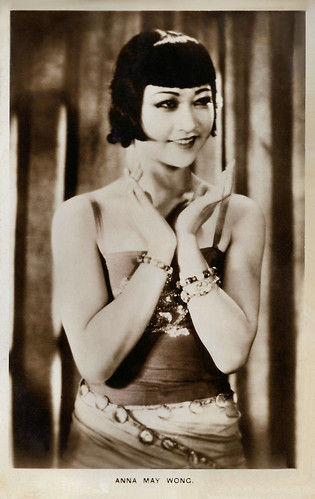
British postcard in the Colourgraph Series, London, no. C 7.
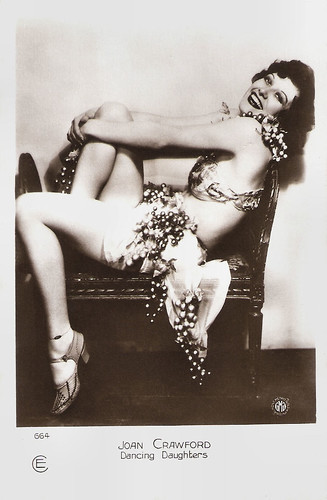
French postcard by Cinémagazine-Edition, no. 664. Photo: MGM. Joan Crawford in Our Dancing Daughters (Harry Beaumont, 1928).
American actress Joan Crawford (1905-1977) became nationally known as a flapper by the end of the 1920s. In the 1930s, her fame rivaled, and later outlasted, MGM colleagues Norma Shearer and Greta Garbo. Crawford often played hardworking young women who find romance and success.

French postcard by Cinémagazine-Edition, Paris, no. 663. Photo: Metro-Goldwyn-Mayer. Joan Crawford and Robert Montgomery in Untamed (Jack Conway, 1929). Collection: Geoffrey Donaldson Institute.

German postcard by Ross Verlag, no. 4855/1, 1929-1930. Photo: Fox Film.
American actress Sally Phipps (1911-1978) had just completed high school when she was selected as a Wampas Baby Star in 1927. As a little kid, she already had made three short films with the legendary film cowboy Broncho Billy, like Broncho Billy and the Baby (Gilbert M. 'Broncho Billy' Anderson, 1915). Her first role as Sally Phipps was in Bertha, the Sewing Machine Girl (Irving Cummings, 1926). Soon she completed appearances in Girls (Eugene Forde, 1927), Love Makes 'Em Wild (Albert Ray, 1927), and Gentlemen Prefer Scotch (George Marshall, 1927). In August 1927 she signed a five-year contract with Fox Film. The sound film probably finished the brief screen career of Sally Phipps.

Austrian postcard by Iris Verlag, no. 813. Photo: Fox Film. Collection: Didier Hanson.

German postcard by Ross Verlag, no. 4252/1, 1929-1930. Photo: Alex Binder, Berlin.
Legendary American dancer and actress Louise Brooks (1906-1985) set the trend of the bobbed haircut and personified the flapper, the rebellious young woman of the 1920s. She played the lead in three European silent film classics: Die Büchse der Pandora/Pandora's Box (1929), Tagebuch einer Verlorenen/Diary of a Lost Girl (1929), and Prix de Beauté/Miss Europe (1930).
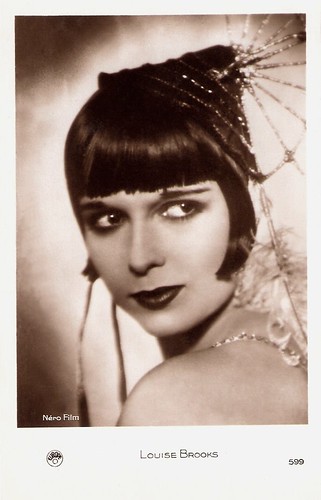
French postcard by Europe, no. 599. Photo: Néro Film.

French postcard in the Les Vedettes de Cinéma Series by A.N., Paris, no. 216. Photo: Metro-Goldwyn Production. Norma Shearer in the - lost - silent film A Slave of Fashion (Hobart Henley, 1925).
American actress Norma Shearer (1902-1983) was the 'First Lady of MGM'. She often played spunky, sexually liberated ingenues, and was the first person to be nominated five times for an Academy Award for acting. Shearer won the Best Actress Oscar for The Divorcee (1930).
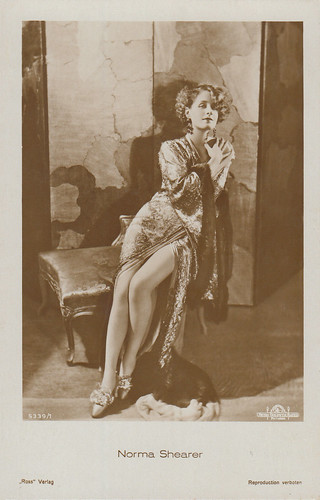
German postcard by Ross Verlag, no. 5339/1, 1930-1931. Photo: George Hurrell / Metro-Goldwyn-Mayer. Publicity still for Let Us Be Gay (Robert Z. Leonard, 1930). Collection: Marlene Pilaete.
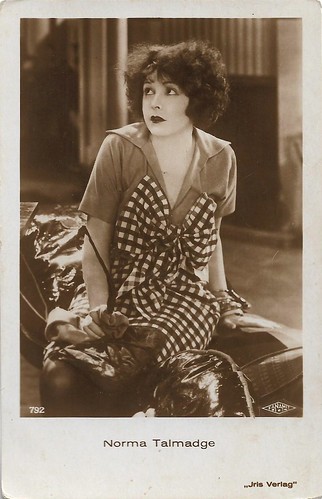
Austrian postcard by Iris Verlag, no. 792. Photo: Fanamet.
Norma Talmadge (1894-1957) was an American actress and film producer of the silent era. A major box-office draw for more than a decade, her career reached a peak in the early 1920s, when she ranked among the most popular idols of the American screen.

French postcard by Europe, no. 666. Photo: Metro-Goldwyn-Mayer.
Marion Davies (1897-1961) was one of the great comedic actresses of the silent era. She starred in nearly four dozen films between 1917 and 1937.
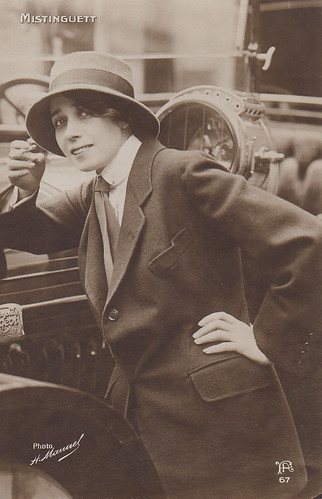
French postcard, no. 67. Photo: H. Manuel. Collection: Marlene Pilaete.
French actress and singer Mistinguett (1875-1956) captivated Paris with her risqué routines. She went on to become the most popular French entertainer of her time and the highest-paid female entertainer in the world. She appeared more than 60 times in the cinema. During a tour of the United States, she was asked by Time magazine to explain her popularity. Her answer was: "It is a kind of magnetism. I say 'Come closer' and draw them to me."
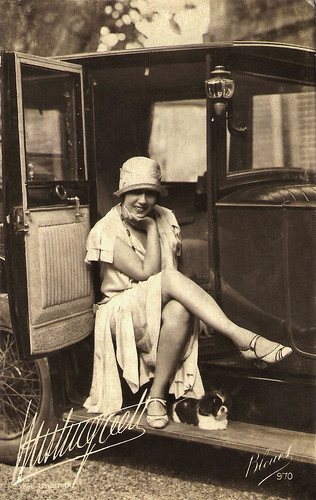
French postcard by Bleuet, no. 970. Photo: Unibsein (?), Paris.

German postcard by Ross Verlag, no. 4076/1, 1929-1930. Photo: Atelier Manassé, Vienna.
Gamine-like silent screen star Betty Balfour (1903-1977) was the ‘British Mary Pickford’. She was a great mimic who started in Music Hall and became known as ‘Britain's Queen of Happiness’. During the 1920s, Balfour was Britain’s most popular actress.

British postcard in the Picturegoer Series, London, no. 226. Sent by mail in Great Britain in 1928. Photo: Balfour Welsh Pearson.
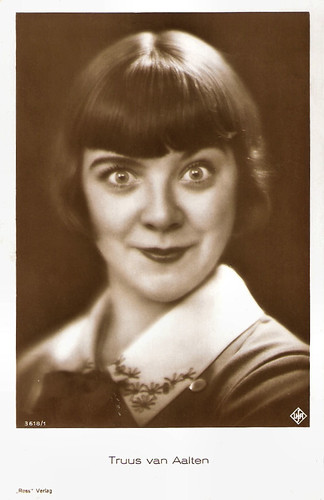
German postcard by Ross Verlag, no. 3618/1, 1928-1929. Photo: Ufa. Collection: Geoffrey Donaldson Institute.
Dutch film star Truus van Aalten (1910-1999) made 29 films in the 1920s and 1930s, and only one of them she made in the Netherlands.

German postcard by Ross Verlag, no. 3823/1, 1928-1929. Photo: Hegewald Film. Truus van Aalten in Die lustigen Vagabunden/The funny vagabonds (Jacob and Luise Fleck, 1928). Collection: Geoffrey Donaldson Institute.
Sources: Sarah Pruitt (History.com), Wikipedia (Dutch and English).
No comments:
Post a Comment